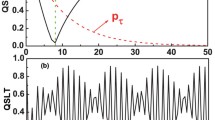Abstract
We study the existence of solutions to the orthogonal dynamics equation, which arises in the Mori-Zwanzig formalism in irreversible statistical mechanics. This equation generates the random noise associated with a reduction in the number of variables. IfL is the Liouvillian, or Lie derivative associated with a Hamiltonian system, andP an orthogonal projection onto a closed subspace ofL 2, then the orthogonal dynamics is generated by the operator (I −P)L. We prove the existence of classical solutions for the case whereP has finite-dimensional range. In the general case, we prove the existence of weak solutions.
Similar content being viewed by others
References
A. Chorin, O. Hald and R. Kupferman,Optimal prediction and the Mori-Zwanzig representation of irreversible processes, Proceedings of the National Academy of Sciences of the United States of America97 (2000), 2968–2973.
A. Chorin, O. Hald and R. Kupferman,Optimal prediction with memory, Physica D166 (2002), 239–257.
K. Chung,A Course in Probability Theory, Academic Press, New York, 1974.
D. Evans and G. Morriss,Statistical Mechanics of Nonequlibrium Liquids, Academic Press, London, 1990.
L. Evans,Partial Differential Equations, American Mathematical Society, Providence, RI, 1998.
K. Friedrichs,Symmetric hyperbolic linear differential equations, Communications on Pure and Applied Mathematics7 (1954), 345–392.
G. Gripenberg, S.-O. Londen and O. Staffans,Volterra Integral and Functional Equations, Cambridge University Press, Cambridge, 1990.
F. John,Partial Differential Equations, Fourth edn., Springer-Verlag, New York, 1982.
W. Just, K. Gelfert, N. Baba, A. Riegert and H. Kantz,Elimination of fast chaotic degrees of freedom: on the accuracy of the Born approximation, Journal of Statistical Physics112 (2003), 277–292.
W. Just, H. Kantz, C. Rödenbeck and M. Helm,Stochastic modelling: replacing fast degrees of freedom by noise, Journal of Physics A34 (2001), 3199–3213.
H. Mori,Transport, collective motion, and Brownian motion, Progress in Theoretical Physics33 (1965), 423–450.
H. Mori, H. Fujisaka and H. Shigematsu,A new expansion of the master equation, Progress in Theoretical Physics51 (1974), 109–122.
A. Pazy,Semigroups of Linear Operators and Applications to Partial Differential Equations, Springer-Verlag, New York, 1983.
M. Reed and B. Simon,Methods of Modern Mathematical Physics, II. Fourier Analysis, Self-Adjointness, Academic Press, San Diego, 1975.
M. Renardy and R. Rogers,An Introduction to Partial Differential Equations, Springer-Verlag, New York, 1993.
W. Rudin,Real and Complex Analysis, Third edn., McGraw-Hill, Boston, 1987.
M. Spivak,A Comprehensive Introduction to Differential Geometry, Second edn., Publish or Perish, Berkeley, CA, 1990.
M. Stone,On one parameter unitary groups in Hilbert space, Annals of Mathematics33 (1932), 643–648.
K. Yosida,Functional Analysis, Sixth edn., Springer-Verlag, New York, 1998.
R. Zwanzig,Problems in nonlinear transport theory, inSystems Far from Equilibrium (L. Garrido, ed.), Springer, New York, 1980, pp. 198–225.
Author information
Authors and Affiliations
Corresponding author
Rights and permissions
About this article
Cite this article
Givon, D., Kupferman, R. & Hald, O.H. Existence proof for orthogonal dynamics and the Mori-Zwanzig formalism. Isr. J. Math. 145, 221–241 (2005). https://doi.org/10.1007/BF02786691
Received:
Issue Date:
DOI: https://doi.org/10.1007/BF02786691




